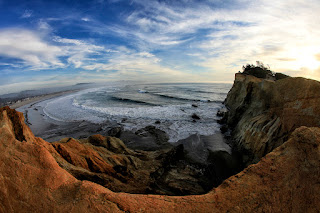 |
| Hallgrimskirkja in Iceland |
You have heard about fisheye lenses and have often seen them used for many weird images:
people with huge distorted faces, pets with massive noses, bent horizons, bizarre buildings, etc. Do you want to use one?
Of course!
The fisheye lens can create absolutely amazing images unlike any other lens. The distortion of the fisheye lens compared to a rectilinear lens adds a completely new dimension to photography: creativity. And as photographers we want to be creative, don't we? But as with all good things, there can be bad results, therefore the lens must be used with discretion and only when it adds to an image, not detracts.
I have a Canon 15mm F2.8 fisheye. It goes everywhere with me; do I use it a lot? No.
A fisheye lens is very light and usually small, therefore it is easy to bring along in your bag or in a pocket. You don't need filters, it would be hard to fit one on the bulbous front lens element, so if I am shooting, the bracket ability of my camera takes away the element of surprise when I review images.
By bracketing, I can combine the sky in one image and the foreground in another if necessary...many times it is not...
I have found that there are certain times a fisheye can do wonders for an image. Night sky images can be incredible. My thought process is simple: if it looks like a fisheye will add something to my composition, I try it...at least by trying the lens, it can be ruled out if the composition fails.
There are even telephoto fisheyes... many manufacturers have fisheye lenses: Canon, Nikon, Sigma, Rokinon.
The lens I have was about $600...they are usually under $1000...some can be found used at Amazon for a lot less.
Here are some examples that may get you motivated to rent or purchase a fisheye:
 |
In this image, taken in Canada on a frozen lake, the camera was tilted down...when you aim down
with a fisheye the horizon becomes a semicircle and curves upward like the earth |
 |
| In this image, the camera was tilted up, thus the horizon lowered to give a dished image. |
 |
| If you can position the horizon dead center with your fisheye, it will be almost level and show very little distortion. |
 |
fisheye in a canyon
Looking up in a canyon at some ice climbers works well with a fisheye...anytime you are in a canyon and looking up, a fisheye can add extra punch to your image because it causes a circular form which the human eye loves. |
 |
This is Cape Kiwanda in Oregon; on this side of the cape there is a long peninsula reaching into the ocean. I thought a fisheye would capture the whole scene in a dramatic way...it seems to work
|
There are times at night when a fisheye can add a large amount of sky plus do good things to shapes in the foreground...the rocks in the next image are immense, but the fisheye compresses them in a unique way.
and as a final image, the fisheye can do some bizarre things to the interiors of abandoned buildings...this is an abandoned boarding house:
A few more thoughts on a fisheye: remember that you can get incredibly close to a subject, sometimes just inches depending upon the lens...mine will focus down to a foot away...also, remember that the field of view is an incredible 180 degrees, something that no rectilinear lens can give you. The widest rectilinear lens is the Canon 11-24mm which has a field of view of 126 degrees.
Try it, you'll like it!






















